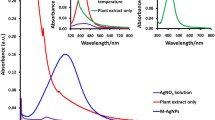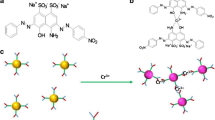Abstract
In the present study, a cost-effective, green and simple synthesis method was applied for preparation of stable silver chloride nanoparticles (AgCl-NPs). The method was done by forming AgCl-NPs from Ag+ ions using aqueous extract of brown algae (Sargassum boveanum) obtained from the Persian Gulf Sea. This extract served as capping agent during the formation of AgCl-NPs. Creation of AgCl-NPs was confirmed by UV–visible spectroscopy, powder X-ray diffraction, energy-dispersive X-ray spectroscopy, and high-resolution transmission electron microscopy, while the morphology and size analyses were characterized using high-resolution transmission electron microscopy and dynamic light scattering. After optimization of some experimental conditions, particularly pH, a simple and facile system was developed for the naked-eye detection of bisphenol-A. Moreover, a theoretical study of AgCl interaction with bisphenol-A was performed at the density functional level of theory in both gas and solvent phases. Theoretical results showed that electrostatic and van der Waal interactions play important roles in complexation of bisphenol-A with AgCl-NPs, which can lead to aggregation of the as-prepared AgCl-NPs and results in color change from specific yellow to dark purple, where a new aggregation band induced at 542 nm appears. The absorbance at 542 nm was found to be linearly dependent on the bisphenol-A concentration in the range of 1 × 10−6–1 × 10−4 M, with limit of detection of 45 nM. In conclusion, obtained results from the present study can open up an innovative application of the green synthesis of AgCl-NPs using brown algae extract as colorimetric sensors.




Similar content being viewed by others
References
Mayer KM, Hafner JH. Localized surface plasmon resonance sensors. Chem Rev. 2011;111(6):3828–57.
Wang J, Zhang P, Li JY, Chen LQ, Huang CZ, Li YF. Adenosine–aptamer recognition-induced assembly of gold nanorods and a highly sensitive plasmon resonance coupling assay of adenosine in the brain of model SD rat. Analyst. 2010;135(11):2826–31.
Zhou W, Gao X, Liu D, Chen X. Gold nanoparticles for in vitro diagnostics. Chem Rev. 2015;115(19):10575–636.
Zhang H, Jin M, Xiong Y, Lim B, Xia Y. Shape-controlled synthesis of Pd nanocrystals and their catalytic applications. Accounts Chem Res. 2012;46(8):1783–94.
Yang Y, Wang X, Cui Q, Cao Q, Li L. Self-assembly of fluorescent organic nanoparticles for iron (III) sensing and cellular imaging. ACS Appl Mater Interfaces. 2016;8(11):7740–8.
Guo X-m WZ, Li W, Wang Z-h, et al. Appropriate size of magnetic nanoparticles for various bio-applications in cancer diagnostics and therapy. ACS Appl Mater Interfaces. 2016;8(5):3092–106.
Chen L, Li H, He H, Wu H, Jin Y. Smart plasmonic glucose nanosensors as generic theranostic agents for targeting-free cancer cell screening and killing. Anal Chem. 2015;87(13):6868–74.
Jana NR, Gearheart L, Murphy CJ. Wet chemical synthesis of silver nanorods and nanowires of controllable aspect ratio. Electronic supplementary information (ESI) available: UV–VIS spectra of silver nanorods. Chem Commun. 2001;7:617–8.
Hanada N, Ichikawa T, Fujii H. Catalytic effect of nanoparticle 3d-transition metals on hydrogen storage properties in magnesium hydride MgH2 prepared by mechanical milling. J Phys Chem B. 2005;109(15):7188–94.
Zhang Y, Yuan X, Wang Y, Chen Y. One-pot photochemical synthesis of graphene composites uniformly deposited with silver nanoparticles and their high catalytic activity towards the reduction of 2-nitroaniline. J Mater Chem. 2012;22(15):7245–51.
Yamauchi Y, Tonegawa A, Komatsu M, et al. Electrochemical synthesis of mesoporous Pt–Au binary alloys with tunable compositions for enhancement of electrochemical performance. J Am Chem Soc. 2012;134(11):5100–9.
Sener G, Uzun L, Denizli A. Lysine-promoted colorimetric response of gold nanoparticles: a simple assay for ultrasensitive mercury (II) detection. Anal Chem. 2013;86(1):514–20.
Chen S, Fang Y-M, Xiao Q, et al. Rapid visual detection of aluminium ion using citrate capped gold nanoparticles. Analyst. 2012;137(9):2021–3.
Kundu S, Lau S, Liang H. Shape-controlled catalysis by cetyltrimethylammonium bromide terminated gold nanospheres, nanorods, and nanoprisms. J Phys Chem C. 2009;113(13):5150–6.
Chen Z, Zhang X, Cao H, Huang Y. Chitosan-capped silver nanoparticles as a highly selective colorimetric probe for visual detection of aromatic ortho-trihydroxy phenols. Analyst. 2013;138(8):2343–9.
Kumar S, Gradzielski M, Mehta S. The critical role of surfactants towards CdS nanoparticles: synthesis, stability, optical and PL emission properties. RSC Adv. 2013;3(8):2662–76.
Alkilany AM, Nagaria PK, Hexel CR, Shaw TJ, Murphy CJ, Wyatt MD. Cellular uptake and cytotoxicity of gold nanorods: molecular origin of cytotoxicity and surface effects. Small. 2009;5(6):701–8.
Annadhasan M, Muthukumarasamyvel T, Sankar Babu V, Rajendiran N. Green synthesized silver and gold nanoparticles for colorimetric detection of Hg2+, Pb2+, and Mn2+ in aqueous medium. ACS Sustainable Chem Eng. 2014;2(4):887–96.
Iravani S. Green synthesis of metal nanoparticles using plants. Green Chem. 2011;13(10):2638–50.
Raveendran P, Fu J, Wallen SL. Completely “green” synthesis and stabilization of metal nanoparticles. J Am Chem Soc. 2003;125(46):13940–1.
Azizi S, Ahmad MB, Namvar F, Mohamad R. Green biosynthesis and characterization of zinc oxide nanoparticles using brown marine macroalga Sargassum muticum aqueous extract. Mater letts. 2014;116:275–7.
Dhas TS, Kumar VG, Karthick V, Angel KJ, Govindaraju K. Facile synthesis of silver chloride nanoparticles using marine alga and its antibacterial efficacy. Spectrochim Acta A. 2014;120:416–20.
Huang JT, Yang XX, Zeng QL, Wang J. A simple green route to prepare stable silver nanoparticles with pear juice and a new selective colorimetric method for detection of cysteine. Analyst. 2013;138(18):5296–302.
Rajeshkumar S, Kannan C, Annadurai G. Green synthesis of silver nanoparticles using marine brown algae Turbinaria conoides and its antibacterial activity. Int J Pharm Bio Sci. 2012;3(4):502–10.
Chen X, Wang C, Tan X, Wang J. Determination of bisphenol A in water via inhibition of silver nanoparticles-enhanced chemiluminescence. Anal Chim Acta. 2011;689(1):92–6.
Muñoz-de-Toro M, Markey CM, Wadia PR, et al. Perinatal exposure to bisphenol-A alters peripubertal mammary gland development in mice. Endocrinology. 2005;146(9):4138–47.
Becke AD. Density-functional thermochemistry. III The role of exact exchange. J Chem Phys. 1993;98(7):5648–52.
Lee C, Yang W, Parr RG. Development of the Colle-Salvetti correlation-energy formula into a functional of the electron density. Phys Rev B. 1988;37(2):785.
Glendening E, Reed A, Carpenter J, Weinhold F. NBO Version 3.1, TCI, vol. 65. Madison: University of Wisconsin; 1998.
Bader RF. Atoms in molecules. Wiley Online Library. 1990.
Foster J, Weinhold F. Natural hybrid orbitals. J Am Chem Soc. 1980;102(24):7211–8.
Reed AE, Weinstock RB, Weinhold F. Natural population analysis. J Chem Phys. 1985;83(2):735–46.
Biegler-König F, Schönbohm J. Update of the AIM2000—program for atoms in molecules. J Comput Chem. 2002;23(15):1489–94.
Frisch M, Trucks G, Schlegel HB, et al. Gaussian 09, revision A. 02, vol. 19. Wallingford, CT: Gaussian, Inc; 2009. p. 227–38.
Gopinath V, Priyadarshini S, Priyadharsshini NM, Pandian K, Velusamy P. Biogenic synthesis of antibacterial silver chloride nanoparticles using leaf extracts of Cissus quadrangularis Linn. Mater Letts. 2013;91:224–7.
Mulvaney P. Surface plasmon spectroscopy of nanosized metal particles. Langmuir. 1996;12(3):788–800.
Fayer MD. Ultrafast infrared vibrational spectroscopy. CRC Press. 2013.
Rajeswari A, Kumar VG, Karthick V, Dhas TS, Potluri SL. Hydrothermal synthesis of hydroxyapatite plates prepared using low molecular weight heparin (LMWH). Colloid Surface B. 2013;111:764–8.
Gómez-Ordóñez E, Rupérez P. FTIR-ATR spectroscopy as a tool for polysaccharide identification in edible brown and red seaweeds. Food Hydrocolloid. 2011;25(6):1514–20.
Choi M, Shin K-H, Jang J. Plasmonic photocatalytic system using silver chloride/silver nanostructures under visible light. J Colloid Interf Sci. 2010;341(1):83–7.
Schürch D, Currao A, Sarkar S, Hodes G, Calzaferri G. The silver chloride photoanode in photoelectrochemical water splitting. J Phys Chem B. 2002;106(49):12764–75.
Kakuta N, Goto N, Ohkita H, Mizushima T. Silver bromide as a photocatalyst for hydrogen generation from CH3OH/H2O solution. J Phys Chem B. 1999;103(29):5917–9.
Bader R, Schleyer PR. Encyclopedia of computational chemistry. Chichester, UK: John Wiley & Sons, Ltd.; 2002.
Bader RF. A bond path: a universal indicator of bonded interactions. J Phys Chem A. 1998;102(37):7314–23.
Author information
Authors and Affiliations
Corresponding author
Ethics declarations
Conflict of interest
The authors declare that they have no conflicts of interest.
Electronic supplementary material
Below is the link to the electronic supplementary material.
ESM 1
(PDF 802 kb)
Rights and permissions
About this article
Cite this article
Khalililaghab, S., Momeni, S., Farrokhnia, M. et al. Development of a new colorimetric assay for detection of bisphenol-A in aqueous media using green synthesized silver chloride nanoparticles: experimental and theoretical study. Anal Bioanal Chem 409, 2847–2858 (2017). https://doi.org/10.1007/s00216-017-0230-0
Received:
Revised:
Accepted:
Published:
Issue Date:
DOI: https://doi.org/10.1007/s00216-017-0230-0




